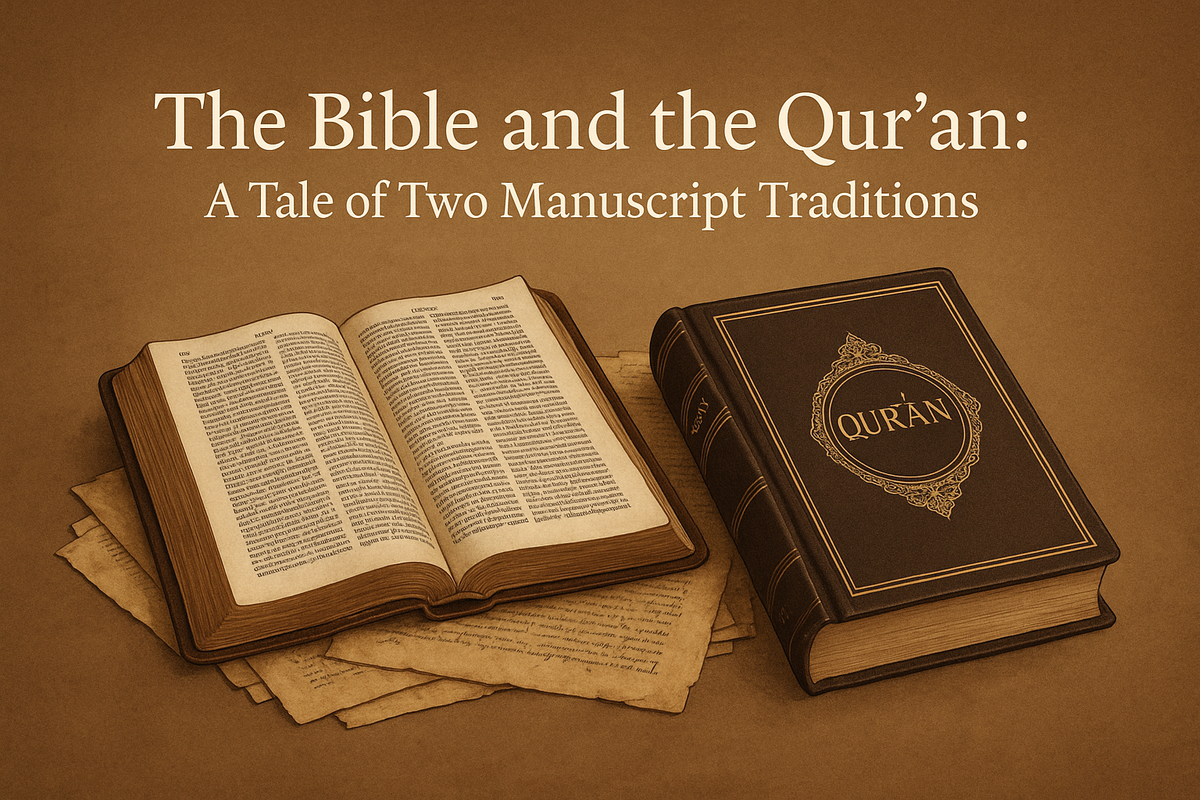

By Dr. Tim Orr
When it comes to matters of eternal significance, no one wants to build their life on myths, half-truths, or legends. We want to know that the foundations of our faith are solid, not shifting sand. That is why investigating the historical reliability of sacred texts is not just an academic exercise—it’s a deeply personal and profoundly spiritual journey. Christianity and Islam both claim to be rooted in divine revelation. Yet when we step into the world of manuscript evidence, we find two very different stories unfolding—one grounded in historical transparency, the other shrouded in mythologized preservation.
The Bible’s Manuscript Tradition: A Story of Astonishing Preservation
When we examine the Bible's manuscript tradition, particularly the New Testament, we find ourselves staring at a mountain of evidence unparalleled in the ancient world. Imagine you are a historian tasked with reconstructing ancient history. You’re sifting through scattered fragments, half-burnt parchments, and damaged scrolls. The New Testament emerges like a brilliant beacon in that dusty, fragile world.
First, the sheer quantity of manuscripts is breathtaking. Over 5,800 Greek New Testament manuscripts have been cataloged. When you add to that another 10,000 Latin manuscripts and 9,300 manuscripts in other ancient languages such as Syriac, Coptic, Georgian, and Armenian, you are looking at over 25,000 ancient witnesses to the New Testament text (Wallace, 2013). By contrast, most ancient classical works survive in fewer than 20 copies, and usually much later copies at that.
For instance, consider Julius Caesar’s Gallic Wars. We base our understanding of Caesar’s campaigns on about ten good manuscripts, the earliest of which is separated from the events by nearly a millennium. Yet no one seriously doubts Caesar’s historical existence or the general trustworthiness of those accounts. In comparison, the New Testament stands on solid ground in terms of quantity and in the closeness of its manuscripts to the original events.
Second, the proximity of these manuscripts to the events they record is remarkable. The John Rylands Papyrus (P52), a tiny fragment of the Gospel of John, has been dated to around AD 125. Since John likely wrote his Gospel around AD 90–95, this fragment was penned within just a few decades of the original (Metzger & Ehrman, 2005). In the ancient world, this is equivalent to finding a firsthand newspaper article from the generation immediately following a historic event. Full manuscripts like Codex Vaticanus and Codex Sinaiticus date to the early 4th century. We have substantial portions of the Bible within just 250–300 years of composition—a record virtually unrivaled for any ancient text.
Third, the geographic spread of New Testament manuscripts enhances our confidence in the text. These manuscripts come from every corner of the ancient Roman Empire: Egypt, Palestine, Asia Minor, Greece, Rome, and even far-flung regions like Ethiopia. This widespread copying and circulation make the idea of a centralized, conspiratorial text editing utterly implausible. If someone had tried to alter the New Testament in Alexandria, they would have had to synchronize their changes across distant Christian communities from Antioch to Rome to Carthage—communities often suffering persecution and cut off from each other by distance and danger. The manuscript evidence shows no such organized corruption.
Fourth, the writings of the early Church Fathers serve as an independent confirmation of the New Testament text. Leaders like Clement of Rome, Ignatius of Antioch, Polycarp, and Justin Martyr quoted so extensively from the New Testament that it is possible to reconstruct nearly the entire text simply from their citations by the early second century (Kruger, 2012). Their quotations come from diverse regions and reflect a text remarkably consistent with what we read today.
Because of this overwhelming evidence, textual critics like Metzger and Ehrman (2005) confidently assert that over 99.5% of the original New Testament can be reconstructed with certainty, and none of the small differences between manuscripts affect any major Christian doctrine. That means the core teachings of the Christian faith—the life, death, resurrection, and deity of Christ—remain untouched and robustly preserved.
Discoveries like the Dead Sea Scrolls confirm a similar preservation pattern in the Old Testament. Before their discovery, skeptics claimed the Hebrew Bible had been corrupted over centuries. But when scholars compared the Isaiah Scroll from Qumran (dated around 250 BC) with the later Masoretic Text (c. AD 900), they found an astonishing word-for-word fidelity in over 95% of the text, with the remaining differences consisting mostly of minor spelling variations that did not affect meaning (Tov, 2012).
In short, the Bible's manuscript tradition invites scrutiny, passes the test, and strengthens faith. It reminds us that Christianity does not ask us to believe blindly but to trust intelligently—to stand on a firm foundation laid by God's providence over centuries.
The Qur'an’s Manuscript Tradition: A Story of Standardization and Complexity
By contrast, when we examine the Qur'an’s manuscript tradition, a very different story unfolds—one not of transparent preservation, but of human editing, political standardization, and suppressed diversity.
Muslim apologists often assert that the Qur'an has been preserved "letter for letter, word for word" from the time of Muhammad until today. But modern manuscript discoveries and even early Islamic sources paint a more nuanced, and frankly more troubled, picture.
The Sana'a Palimpsest, discovered during renovations of the Great Mosque of Sana'a in Yemen in 1972, is perhaps the most significant Qur'anic manuscript find of modern times. This document contains a lower erased text and an upper corrected text. Carbon dating places the lower text within 25–75 years of Muhammad’s death—a crucial period when the Qur'an should have been fixed if the Muslim claim were true (Puin, 2000). Yet the lower text displays major variations compared to the standardized Qur'an: different wordings, missing verses, and even alternate surah orders. This is not just a minor scribal error; it points to fluidity in the transmission of the text during its formative years.
Other historical evidence shows similar instability. The codex of Ibn Mas'ud, one of Muhammad’s closest companions, reportedly omitted Surah 1 and the last two surahs (113 and 114), which are now considered essential in the Qur'an (Jeffery, 1937). Ubayy ibn Ka'b’s codex, another early authority, contained two additional surahs not found in the modern Qur'an. These early variant codices indicate that there was no universally agreed-upon text in the first century of Islam.
Moreover, Islamic tradition itself acknowledges variations. Muhammad is reported to have said, "The Qur'an was revealed in seven ahruf (modes)" (Sahih al-Bukhari, 4992; Sahih Muslim, 819a). These "modes" remain deeply debated: are they dialectical differences, stylistic variances, or genuine textual divergences? Whatever they were, the tradition shows that even among Muhammad’s followers, the Qur'an existed in multiple forms during his lifetime.
Efforts to stabilize the Qur'an's text came later, particularly under the caliphate of Uthman (AD 644–656), who famously ordered all variant copies to be burned and issued a standardized version (Cook, 2000). This textual consolidation shows that the early Qur'an was diverse enough to require an official purge and standardization.
The situation grew even more complex with the emergence of the ten canonical qira'at (readings), each with its chain of transmission. These canonical readings were accepted centuries after Muhammad and often differ in vowels and even in the consonantal text (rasm) itself. For instance, in Surah 2:222, one reading emphasizes human agency ("those who purify themselves"), while another shifts the emphasis to divine action ("those who are purified")—a theologically significant difference (Déroche, 2014).
The Codex Parisino-Petropolitanus, an early Qur'an manuscript now in Paris, also contains substantial textual variants compared to today’s standard Hafs version. These manuscripts confirm that textual fluidity, not rigid preservation, characterized the Qur'an’s transmission in the early centuries.
Thus, while Islamic theology emphasizes perfect preservation (tahrif), the historical evidence tells a story of human intervention, standardization, and evolving text traditions. Like any document of antiquity, the Qur'an was subject to historical transmission processes—processes that leave fingerprints of change.
Why This Matters
When you think about it, trust is everything. If you were standing on a bridge, wouldn't you want to know whether it was built on solid engineering principles or hastily assembled with shifting pieces? Regarding the Bible, we are standing on a steel and concrete bridge—tested by history, attacked by skeptics, but still standing strong. Concerning the Qur'an, the bridge is real, but the evidence does not support the claim that it was divinely dropped fully formed and perfectly preserved.
Christianity boldly asserts, "Test us." Open the Bible, examine its history, and challenge its claims. We have nothing to hide—and much to celebrate. The historical reliability of Scripture is not a side issue; it is a powerful confirmation that God is faithful in speaking to humanity and preserving His words across millennia.
References
Cook, M. (2000). The Koran: A Very Short Introduction. Oxford University Press.
Déroche, F. (2014). The Making of the Arabic Book: The Transmission of the Qur'an in Early Islam. Brill.
Jeffery, A. (1937). Materials for the History of the Text of the Qur'an: The Old Codices. Brill.
Kruger, M. J. (2012). Canon Revisited: Establishing the Origins and Authority of the New Testament Books. Crossway.
Metzger, B. M., & Ehrman, B. D. (2005). The Text of the New Testament: Its Transmission, Corruption, and Restoration (4th ed.). Oxford University Press.
Puin, G. R. (2000). Observations on Early Qur'an Manuscripts in Sana'a. In S. Wild (Ed.), The Qur'an as Text (pp. 107–111). Brill.
Tov, E. (2012). Textual Criticism of the Hebrew Bible (3rd ed.). Fortress Press.
Wallace, D. B. (2013). Revisiting the Corruption of the New Testament. Kregel Academic.
Who is Dr. Tim Orr?
Tim serves full-time with Crescent Project as the assistant director of the internship program and area coordinator, where he is also deeply involved in outreach across the UK. A scholar of Islam, Evangelical minister, conference speaker, and interfaith consultant, Tim brings over 30 years of experience in cross-cultural ministry. He holds six academic degrees, including a Doctor of Ministry from Liberty University and a Master’s in Islamic Studies from the Islamic College in London.
In addition to his ministry work, Tim is a research associate with the Congregations and Polarization Project at the Center for the Study of Religion and American Culture at Indiana University Indianapolis. His research interests include Islamic antisemitism, American Evangelicalism, and Islamic feminism. He has spoken at leading universities and mosques throughout the UK—including Oxford University, Imperial College London, and the University of Tehran—and has published widely in peer-reviewed Islamic academic journals. Tim is also the author of four books.
